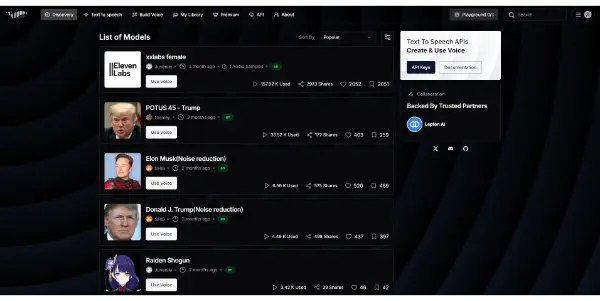Fish Audio

An advanced AI text-to-speech platform. Create realistic voices, customize them and easily integrate them into your projects thanks to a powerful API
Fish Audio: A Deep Dive into AI-Powered Text-to-Speech
Fish Audio is an advanced AI-powered text-to-speech (TTS) platform designed for developers and content creators seeking realistic and customizable voices. Leveraging cutting-edge AI technology, Fish Audio allows users to generate high-quality speech from text, clone voices, and easily integrate these capabilities into their applications via a robust API. This article provides a comprehensive overview of Fish Audio's features, benefits, applications, and how it compares to competitors.
What Fish Audio Does
Fish Audio transforms written text into natural-sounding speech using sophisticated AI algorithms. It goes beyond basic TTS by offering powerful voice customization options and a seamless integration process for developers. The platform focuses on delivering a realistic and expressive auditory experience, suitable for a broad range of applications.
Main Features and Benefits
- Realistic Voice Generation: Fish Audio utilizes advanced neural networks to produce highly natural-sounding speech, minimizing the robotic quality often associated with traditional TTS systems.
- Voice Cloning: A key differentiator is its voice cloning capability, allowing users to create synthetic voices that closely mimic specific individuals (with proper consent and legal considerations). This opens up exciting possibilities for personalized content and unique branding.
- Customization Options: Beyond cloning, users can fine-tune various aspects of the generated speech, including intonation, pitch, speed, and emphasis, enabling precise control over the final audio output.
- Powerful API: A well-documented API enables easy integration into various applications and workflows, simplifying the development process for developers. This allows for seamless embedding of Fish Audio's functionality into existing projects.
- Multiple Languages and Accents: Fish Audio likely supports a range of languages and accents (though specific details would need confirmation on their website), expanding its versatility and global reach.
- High-Quality Audio: The platform prioritizes audio quality, resulting in clear, crisp speech ideal for professional applications.
Use Cases and Applications
Fish Audio's versatility makes it suitable for a wide array of applications, including:
- Accessibility: Creating audio versions of written content for visually impaired users.
- E-learning: Generating engaging audio for online courses and educational materials.
- Video Production: Adding realistic voiceovers to videos without the need for professional voice actors.
- Gaming: Developing realistic character voices for video games.
- Interactive Voice Response (IVR) Systems: Building more natural and engaging IVR experiences.
- Audiobooks: Generating audiobooks from existing text content.
- Marketing and Advertising: Creating personalized audio messages and advertisements.
Comparison to Similar Tools
Fish Audio competes with other AI-powered TTS platforms like Amazon Polly, Google Cloud Text-to-Speech, and Microsoft Azure Text-to-Speech. While these established players offer strong features, Fish Audio distinguishes itself with its focus on:
- Advanced Voice Cloning: Many competitors offer less sophisticated voice cloning capabilities or none at all.
- Intuitive Customization: Fish Audio aims to provide user-friendly customization tools for non-technical users as well.
- API-first approach: A strong emphasis on API integration makes it particularly attractive for developers.
The specific strengths compared to competitors depend on the individual user's needs and priorities. A detailed comparison table against direct competitors would require reviewing their individual feature sets and pricing models.
Pricing Information
Fish Audio operates on a freemium model. This typically means a free tier with limited usage and features, and paid plans offering greater access and capabilities. Specific pricing details (number of characters/minutes, API call limits, etc.) can be found on the official Fish Audio website.
Disclaimer: This article provides general information about Fish Audio based on the provided description. Specific features, pricing, and availability may vary. Always refer to the official Fish Audio website for the most up-to-date and accurate information.